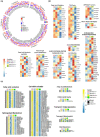PTEN-induced kinase 1 is associated with renal aging, via the cGAS-STING pathway
- PMID: 37183600
- PMCID: PMC10352563
- DOI: 10.1111/acel.13865
PTEN-induced kinase 1 is associated with renal aging, via the cGAS-STING pathway
Abstract
Mitochondrial dysfunction is considered to be an important mediator of the pro-aging process in chronic kidney disease, which is continuously increasing worldwide. Although PTEN-induced kinase 1 (PINK1) regulates mitochondrial function, its role in renal aging remains unclear. We investigated the association between PINK1 and renal aging, especially through the cGAS-STING pathway, which is known to result in an inflammatory phenotype. Pink1 knockout (Pink1-/- ) C57BL/6 mice and senescence-induced renal tubular epithelial cells (HKC-8) treated with H2 O2 were used as the renal aging models. Extensive analyses at transcriptomic-metabolic levels have explored changes in mitochondrial function in PINK1 deficiency. To investigate whether PINK1 deficiency affects renal aging through the cGAS-STING pathway, we explored their expression levels in PINK1 knockout mice and senescence-induced HKC-8 cells. PINK1 deficiency enhances kidney fibrosis and tubular injury, and increases senescence and the senescence-associated secretory phenotype (SASP). These phenomena were most apparent in the 24-month-old Pink1-/- mice and HKC-8 cells treated with PINK1 siRNA and H2 O2 . Gene expression analysis using RNA sequencing showed that PINK1 deficiency is associated with increased inflammatory responses, and transcriptomic and metabolomic analyses suggested that PINK1 deficiency is related to mitochondrial metabolic dysregulation. Activation of cGAS-STING was prominent in the 24-month-old Pink1-/- mice. The expression of SASPs was most noticeable in senescence-induced HKC-8 cells and was attenuated by the STING inhibitor, H151. PINK1 is associated with renal aging, and mitochondrial dysregulation by PINK1 deficiency might stimulate the cGAS-STING pathway, eventually leading to senescence-related inflammatory responses.
Keywords: PINK1; STING; chronic kidney disease; mitochondria; renal aging.
© 2023 The Authors. Aging Cell published by the Anatomical Society and John Wiley & Sons Ltd.
Conflict of interest statement
The authors declare no conflicts of interest.
Figures






References
Publication types
MeSH terms
Substances
LinkOut - more resources
Full Text Sources
Medical
Molecular Biology Databases
Research Materials

